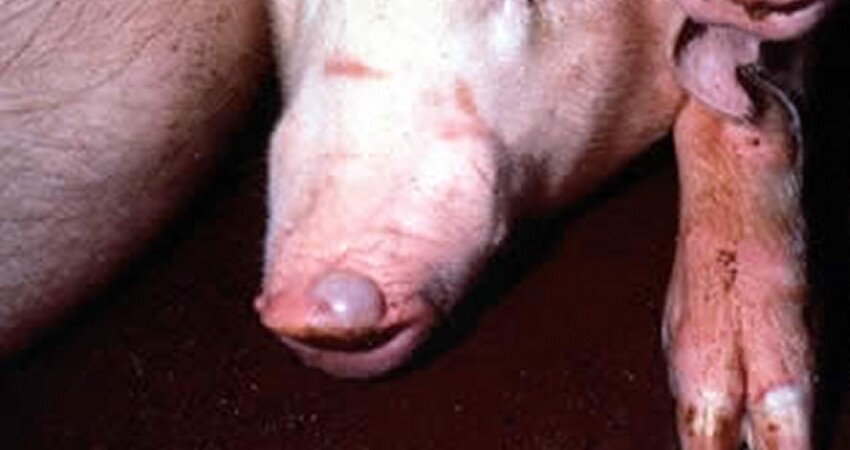

Foot and Mouth Disease is one of the livestock diseases that a severe and cannot be ignored in Africa. A range of clinical signs may indicate the presence of foot-and-mouth disease (FMD) in pigs.
Typical clinical signs of FMD in pigs include:
– Pyrexia
– Severe foot lesions and lameness, with detachment of the claw horn, especially when housed on concrete
– Vesicles on pressure points of limbs, especially along the carpus, resulting in knuckling
– Vesicular lesions on the snout and Abortion.
The clinical signs of foot-and-mouth disease (FMD) are similar to those of a number of other animal diseases.
Diseases that are clinically indistinguishable from FMD include: vesicular stomatitis, swine vesicular disease and vesicular exanthema.
If you suspect an animal has foot-and-mouth disease (FMD), follow these steps:
– Immediately report the suspected case to the concerned authorities.
– Collect as much relevant history and clinical and epidemiological information as possible. Using this information, authorities will be able to undertake likelihood and risk assessments that will help to inform advice regarding next steps.
– Apply enhanced biosecurity measures. This may include working with livestock owners to implement the following:
- Immediately isolate the affected animals and keep them away from the edge of the property. Prevent people who have been in contact with the suspected stock from contacting other at-risk animals. Do not allow animals such as dogs, cats and poultry to have contact with stock, as they may act as fomite vectors and spread the disease.
- Prevent animals being moved to or from the property. Suspect stock should not be moved near to, or across, a public road.
- Prevent movement from the property of vehicles, clothing, animal feed, waste material or anything that has been in contact with the suspect stock.
- Prevent visitors or vehicles entering the property. If possible, put a ‘No entry’ sign on farm gates and other access points.
- Prevent people on the property from leaving. Anyone who must leave for emergency reasons must shower first, leaving all farm clothes on the property and taking special care to ensure footwear is particularly clean, with no dirt or faeces left on the soles or on any remaining clothing.
– Appropriate sampling and testing will be required to confirm or rule out FMD. Biosecurity Queensland officers will provide relevant advice.
FMD control strategies include:
- minimising disease spread by implementing strict biosecurity and movement controls over animals, animal products, and fomites in declared areas
- stopping the movement of all susceptible livestock, initially for a period of 72 hours, to allow time to assess the epidemiological situation
- tracing and surveillance to identify infected animals and animals in contact with infected animals
- destroying infected animals and animal products and disposing of them in a sanitary way
- decontaminating facilities, products, equipment and objects to limit the spread of the virus
- running public awareness campaigns
- enabling relief and recovery programs to minimise animal and human welfare issues.
Typical clinical signs of FMD in pigs include:
– Pyrexia
– Severe foot lesions and lameness, with detachment of the claw horn, especially when housed on concrete
– Vesicles on pressure points of limbs, especially along the carpus, resulting in knuckling
– Vesicular lesions on the snout and Abortion.
The clinical signs of foot-and-mouth disease (FMD) are similar to those of a number of other animal diseases.
Diseases that are clinically indistinguishable from FMD include: vesicular stomatitis, swine vesicular disease and vesicular exanthema.
If you suspect an animal has foot-and-mouth disease (FMD), follow these steps:
– Immediately report the suspected case to the concerned authorities.
– Collect as much relevant history and clinical and epidemiological information as possible. Using this information, authorities will be able to undertake likelihood and risk assessments that will help to inform advice regarding next steps.
– Apply enhanced biosecurity measures. This may include working with livestock owners to implement the following:
- Immediately isolate the affected animals and keep them away from the edge of the property. Prevent people who have been in contact with the suspected stock from contacting other at-risk animals. Do not allow animals such as dogs, cats and poultry to have contact with stock, as they may act as fomite vectors and spread the disease.
- Prevent animals being moved to or from the property. Suspect stock should not be moved near to, or across, a public road.
- Prevent movement from the property of vehicles, clothing, animal feed, waste material or anything that has been in contact with the suspect stock.
- Prevent visitors or vehicles entering the property. If possible, put a ‘No entry’ sign on farm gates and other access points.
- Prevent people on the property from leaving. Anyone who must leave for emergency reasons must shower first, leaving all farm clothes on the property and taking special care to ensure footwear is particularly clean, with no dirt or faeces left on the soles or on any remaining clothing.
– Appropriate sampling and testing will be required to confirm or rule out FMD. Biosecurity Queensland officers will provide relevant advice.
FMD control strategies include:
- minimising disease spread by implementing strict biosecurity and movement controls over animals, animal products, and fomites in declared areas
- stopping the movement of all susceptible livestock, initially for a period of 72 hours, to allow time to assess the epidemiological situation
- tracing and surveillance to identify infected animals and animals in contact with infected animals
- destroying infected animals and animal products and disposing of them in a sanitary way
- decontaminating facilities, products, equipment and objects to limit the spread of the virus
- running public awareness campaigns
- enabling relief and recovery programs to minimise animal and human welfare issues.
 Contact Jaguza Support
Contact Jaguza Support